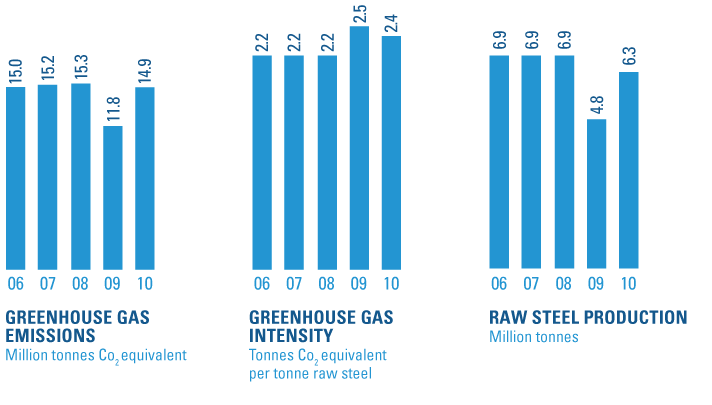Steelmaking generates greenhouse gas emissions, mainly carbon dioxide, both directly when making iron and steel, and indirectly through the use of electricity and gas. The rate of greenhouse gas generation, and the overall efficiency of operations, is heavily influenced by the production output. The Company remains committed to reducing the greenhouse gas intensity of our operations and continuously improving our environmental footprint.
BlueScope Steel's absolute greenhouse gas emissions in FY10 totalled 14.9 million tonnes (CO2 equivalent). During the year the commissioning of No.5 Blast Furnace at Port Kembla and changes to fuel mix at both Port Kembla blast furnaces influenced this overall result. The overall greenhouse intensity was 2.4 tonnes (CO2 equivalent) of GHG emissions per tonne of raw steel manufactured, which was a slight improvement on the previous year, however higher than historical levels.
In the lead up to the financial downturn, BlueScope Steel's total global greenhouse gas emissions (Scope 1 and Scope 2) fluctuated between 14.7 and 15.3 million tonnes (CO2 equivalent) per annum. During this period of relative economic stability, incremental energy and greenhouse gas efficiency improvements maintained the global greenhouse gas intensity for the Company at approximately 2.2 tonnes (CO2 equivalent) of GHG emissions per tonne of raw steel manufactured. BlueScope Steel is working towards returning to these levels of performance as soon as practicable, however this is largely dependent on being able to return to full production volumes if improving market conditions allow.
BlueScope Steel’s total Scope 1 (direct emissions) and Scope 2 (indirect emissions from consumption of purchased electricity, heat or steam), raw steel production output and greenhouse gas intensity are depicted in the accompanying graphs.


